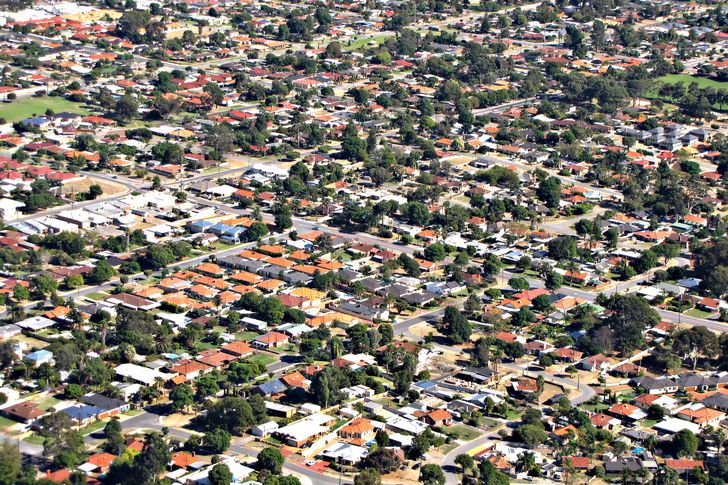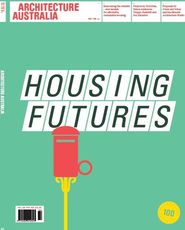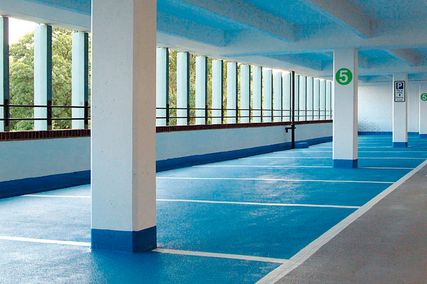
An Australian suburb from the air.
Image: rgbstock
The idea of home has long influenced the Australian psyche, particularly through the concept of the Great Australian Dream. This defining value of Australian society is more than an aspiration for home ownership; it is a yearning for domestic “bliss,” a longing to make a house into a home, creating somewhere we feel we belong and allowing us to have some control over our ability to live the life we desire. This dream is changing. The households that we form are altering, pressures on land availability are increasing the supply of apartments and other medium-density dwellings, and younger and more culturally diverse generations are more resistant to, or cannot afford, the dream. In this essay we explore suburban domestic life in contemporary Australia. What are its “modes of domesticity”: our ideals of home, the people we share homes with, and our everyday practices?
The Australian Bureau of Statistics (ABS) provides some answers through its long-term demographic tracking of different household types, which include couple families, couple families with children (nuclear families), same-sex couple families, single-parent families, and multi-family, single-occupancy and group households. Over the twentieth century household patterns changed considerably. Household sizes dropped from an average of 4.5 persons in 1911 to 2.6 persons in 2006, and continue to decline, with 2.3 persons projected by 2026. Fewer Australians are living in traditional nuclear families, more are living alone or with other non-related adults, and more couples without children – especially empty nesters – are expected. These shifting demographics complicate homemaking practices and meanings of home formerly associated with the nuclear family, the dominant household type during the twentieth century.
The growth in single-occupancy households has been fastest. The share of lone-person households increased from 15.7% in 1976 to 24.4% in 2006, and is tipped to reach 30.2% by 2026 (3.1 million households). Traditionally, widowed older women comprised much of the demographic, but this has changed. The life expectancy gap between women and men is narrowing, reducing the time older people spend widowed, and so older women are less likely to live alone than in the past. There is also increasing propensity for younger and middle-aged people to live alone, and these age cohorts now constitute a larger proportion of lone-person households. This trend is influenced by changes in marriage and divorce. Younger people are deferring the age of partnering or marriage, living alone in the meantime, while increasing separation and divorce among those in their middle years often results in living alone. There is a shifting gender pattern, too: men are more common as single occupiers in these age cohorts. In the 20–29 years “un-partnered” group, men are more likely to live alone than women, while 40% of separated/divorced men aged 25–44 years live alone, compared with 12% of separated/divorced women (who are more likely to be lone parents). Beyond the age of fifty, women remain more likely single occupiers than men.
Given the growth in single occupancy, and its extension across gender and age cohorts, it is timely to consider the homemaking practices and meanings of home for people living alone. How does one “make” home and “do” domesticity alone, without family or other residents? Andrew is pondering this question through research on men’s changing domestic lives in Sydney, which includes men living alone (35–75 years) as a case study. Some of their meanings of home are congruent with ideals taken for granted, like the desire for home to be safe, secure and private. Living alone enhances some normative meanings of home: the link between home and identity is amplified in single occupancy, where no other residents impinge upon decisions about interior design, lifestyle or time use. But some homemaking practices of single occupiers necessarily differ. Responsibility for housework, for example, is not shared.
Relations with family and friends beyond the dwelling are significant in the lives of people living alone. ABS data indicate that single occupiers have, on average, more frequent phone and email contact with family and friends outside their homes than people in multi-person households. This stretches the significant relations that are part of homemaking, and which help constitute a sense of home, beyond the dwelling. Yet single occupiers are also at greater risk of problems linked to mental health and emotional wellbeing, which affects meaningful relations with others. For some, living alone can contribute to social isolation and loneliness, and this is especially noted among men aged 25–44 years. The absence of intra-household relations is, therefore, a double-edged sword: single occupiers have more control over relations with others and their impact on domestic practices, but they also have to invest more effort into maintaining significant relations with family and friends.
Traditional nuclear families – heterosexual couples with children – are projected to remain a significant form of living arrangement for many Australians. Most of these families will continue to live in detached houses, which are getting larger. The average size of new houses in Australia grew from 162 square metres in 1985 to 239 square metres in 2006. Here, domesticity is characterized by a tension between a search for privacy and a yearning for communal activities. Research Robyn conducted on the popularly derided “McMansions” found that families valued their spaciousness because it provided opportunities for the family to be together, relax and feel secure in their shared living space. Domesticity for them was about familial togetherness: a space where they could entertain, study, unwind and be together. The ability of individual family members to secure and maintain a sense of physical and social isolation from other family members was also valued. Again, larger houses were important here, because they were seen as facilitating generational privacy, allowing children and adults to be independent.
At the neighbourhood scale we see similar trends. At one level, the private home – as opposed to the extended family or the community – is the fulcrum of a family’s social life. Most familial socializing is done in the home, and households estimate that the bulk of their social and recreational needs can be fulfilled within their home. We see, then, a demand for large, open-plan spaces connected to both kitchens and outdoors. But life beyond the house remains important. An increasing number of suburban families live in community-title developments where, in addition to their own house, they share ownership and access to facilities like clubhouses and swimming pools. Living in these developments is relatively unusual in Australian suburbia, unlike in North America where suburban common-interest developments are increasingly the norm. They are embraced because of the ways they dovetail with the harried pace of contemporary family life. Common facilities take the time burden of maintenance away from individuals. A visit to the communal pool is perceived to be more private than the council pool, and ensures parents’ focus is on their children rather than domestic chores they would be doing if the pool was in their own backyard. Chance meetings with neighbours, often while walking the dog, were valued as important to their sense of wellbeing.
The nuclear family’s place as the predominant family type in Australia is being taken by couples without children. This is partly due to the increasing propensity for couples to remain childless, but is largely due to the ageing of the population. Moreover, the modes of domesticity of same-sex couples are also important, but not well known. The 2006 census counted over 25,000 same-sex families. Of these, 53% were male couples, 47% were female couples, and 10% had dependent children. In terms of changing demographics and domesticities, it is critical to recognize that same-sex families are widespread. Increasingly visible thanks to legal changes, same-sex families are not the “ghettoized geographical minority” implied in popular culture. Certainly, there are inner-city concentrations (notably in Sydney, Melbourne and Brisbane), but there are significant suburban and regional congregations. In particular, female couples and same-sex couples with children (largely female couples) are more likely to be found in above-average numbers in suburban and regional areas than male couples.
Andrew has conducted research with suburban same-sex families, exploring their domestic lives and their meanings of home. Some same-sex couples feel inhibited in public, where small signs of affection (kissing, hugging, holding hands) might be met with disapproval, and thus homes are significant as private spaces where they can “be themselves” and build their relationships. A shared commitment to renovation, home design, household purchases and domestic activities can help consolidate and strengthen same-sex partnerships. Over half of the couples Andrew spoke to also maintain separate “personal” rooms within their homes. These are important for preserving each partner’s sense of self and preventing relationship tensions caused by “overcrowding.” While fears of harassment mean some couples are anxious about the visibility of their homes, others reach out and build bridges with neighbouring heterosexual families through social gatherings (dinners, barbecues) at home.
Living the Great Australian Dream doesn’t end with an aerial view of expanding suburban houses. How we live and what we do, with whom, inside, turns these into homes. Looking inside the front door reveals new demographic and domestic patterns. Alongside growing domestic forms like single occupancy and same-sex families, nuclear families are making homes differently. As family and household types shift and proliferate, so too do their homemaking practices. These changes help us to understand transformations in suburban life and the meaning of home.
References
Australian Bureau of Statistics, Year Book Australia, 2005, Catalogue no. 1301.0; Living alone, Australian Social Trends, December 2009, Catalogue no. 4102.0; “Australian households: the future”, Australian Social Trends, December 2010, Catalogue no. 4102.0; “Households and families”, Year Book Australia, 2009–2010, Catalogue no. 1301.0.
Darian Clark, “The lone person household demographic: trends and implications”, Australian Social Policy 2002–2003, 2004: 75–99.
Robyn Dowling, Roland Atkinson and Pauline McGuirk, “Privatism, Privatisation and Social Distinction in Master-Planned Residential Estates”, Urban Policy and Research 28 (4), 2010: 391–410.
Robyn Dowling, “Accommodating open plan: clutter, children and containment in suburban Sydney”, Australia, Environment and Planning A 40 (3), 2008: 536–549.
Andrew Gorman-Murray, “Gay and lesbian couples at home: identity work in domestic space”, Home Cultures 3 (2), 2006: 145–168.
Andrew Gorman-Murray and Chris Brennan-Horley, “The geography of same-sex families in Australia: implications for regulatory regimes”, in Paula Gerber and Adiva Sifris (eds.), Current Trends in the Regulation of Same-Sex Relationships (Federation Press, Sydney, 2011): 48–64.
Karina Luzia, “Travelling in your backyard: the unfamiliar places of parenting”, Social and Cultural Geography 11 (4), 2010: 359–375.
Source

Discussion
Published online: 30 Aug 2011
Words:
Andrew Gorman-Murray,
Robyn Dowling
Issue
Architecture Australia, May 2011














